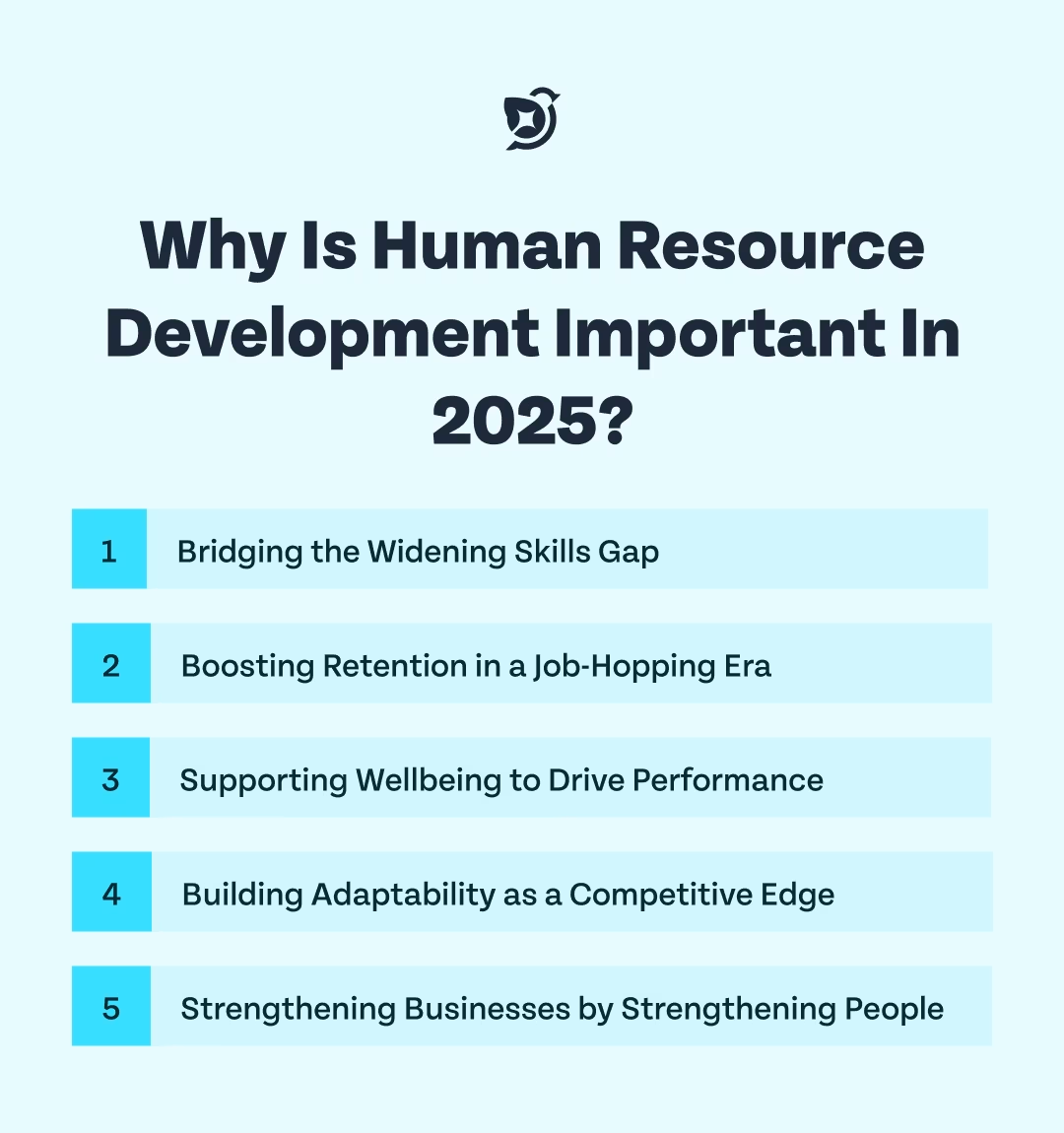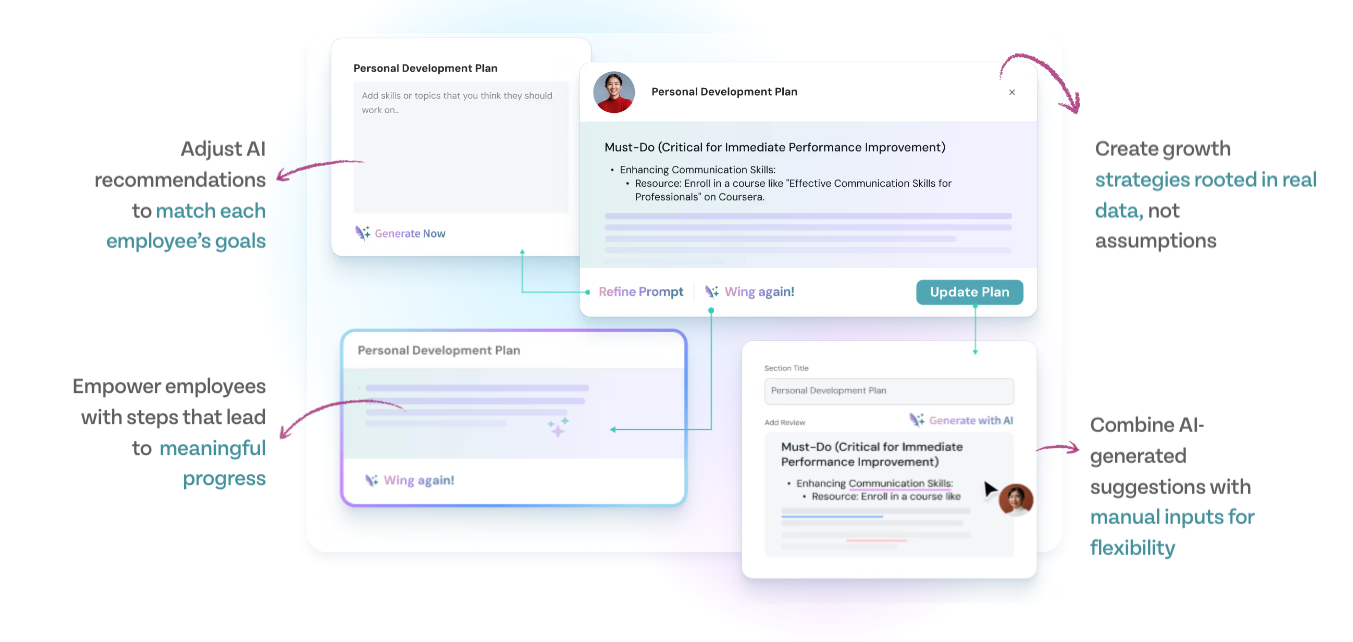Imagine stepping into a workplace where people don’t just do their jobs—they thrive, learn continuously, and feel supported to tackle tomorrow’s challenges. That kind of workplace doesn’t come about by accident. It’s built through human resource development (HRD).
HRD is more than a training department or a set of workshops. It’s a strategic approach to unlocking human potential while aligning individual growth with organizational goals. In this blog, we'll explore what Human Resource Development is, why it matters now, its core components, benefits, and a step-by-step roadmap to implement it effectively.
What is Human Resource Development?
Human resource development is the ongoing process of improving people’s skills, knowledge, and capabilities so that both individuals and organizations grow. It’s not just about sending employees to a training session—it’s a philosophy of continuous learning.
Scholars define HRD as:
- A multidisciplinary field (drawing from psychology, sociology, and education) that explores how knowledge is created and shared.
- A strategic process, described by Richard A. Swanson as “developing and unleashing human expertise” to improve performance.
- A subset of HR, according to Drexel University, that emphasizes training, culture building, and long-term skill sharpening.
In practice, HRD covers three big dimensions:
- Training and development – helping employees excel in their current roles and stay resilient.
- Career development – preparing employees for future opportunities through coaching, mentorship, and planning.
- Organizational development – shaping culture, processes, and systems so innovation can thrive.
The beauty of HRD is that it happens formally (like structured workshops, certifications, online courses) and informally (like mentoring, shadowing, or peer learning). Both matter, and both must connect back to the organization’s strategic goals.
Why is Human Resource Development Important in 2025?
The short answer: because the world of work is moving too fast not to invest in people.
The longer answer? Let’s break it down.
Organizations today are navigating AI adoption, automation, hybrid work models, rising employee expectations, and global competition for talent. In such a case, relying on outdated training once a year or expecting employees to “figure it out” simply won’t cut it. Human Resource Development (HRD) has become the strategic muscle organizations need to stay competitive.
Here’s why:
1. Bridging the Widening Skills Gap
Every year, new technologies emerge and old skills become obsolete. A PwC survey found that 63% of CEOs worry about the availability of critical skills—and they should. Without HRD, employees risk falling behind, and companies risk losing ground. Development programs, whether through upskilling, reskilling, or micro-learning give employees the tools to keep pace with change.
2. Boosting Retention in a Job-Hopping Era
It’s no secret that loyalty has shifted. Employees are far more willing to switch jobs if they don’t see growth opportunities. According to LinkedIn Learning, 94% of employees would stay longer if their company invested in their careers. Think about that: nearly everyone is telling us the same thing. HRD isn’t just about skill-it’s about showing people they have a future in your organization. That’s retention gold.
3. Supporting Wellbeing to Drive Performance
Productivity isn’t only about hard skills—it’s about how people feel. Oxford University research shows that happy employees are 13% more productive. HRD programs that incorporate wellbeing—like stress management, flexible learning, or coaching—don’t just train people, they help them feel supported. And when employees feel supported, they perform better.
4. Building Adaptability as a Competitive Edge
Markets are volatile, and entire industries can shift in a matter of months. The organizations that thrive aren’t necessarily the biggest—they’re the most adaptable. HRD creates a culture of continuous learning and agility, so when new challenges or opportunities arise, your people are ready.
5. Strengthening Businesses by Strengthening People
This is the real takeaway: HRD isn’t charity for employees—it’s strategy for organizations. By investing in learning, development, and growth, you’re not only future-proofing your workforce, you’re future-proofing your business. Companies that embed HRD into their DNA build resilience, innovation, and long-term success.

What are the Objectives of Human Resource Development?
The objective of HRD isn’t just to “train people.” Training is one piece of the puzzle, but true human resource development is about helping individuals and organizations grow together. It ensures that employees don’t just perform tasks—they evolve, adapt, and contribute to the bigger vision of the company.
Think of HRD as a bridge: on one side are individual aspirations, and on the other are organizational goals. The bridge keeps both connected so that as employees progress, the business thrives too.
Here are the key objectives, and why they matter:
1. Boost Productivity and Performance
At the most basic level, HRD aims to help people work better. Well-designed development initiatives—whether it’s training on new technology, leadership coaching, or workflow optimization—make employees more competent and confident. That confidence translates into better decisions, smoother teamwork, and higher output. In fast-moving markets, this isn’t optional; it’s survival.
2. Foster Continuous Skill Development
The shelf life of skills is shrinking. A technical skill you learned five years ago might already be outdated. HRD ensures your workforce isn’t just catching up with today’s demands but is ready for tomorrow’s. This could mean introducing reskilling programs for automation, digital literacy initiatives, or leadership skills for first-time managers. The goal: future-proof your talent.
3. Create a Culture of Innovation
Innovation doesn’t happen in rigid environments. HRD gives people the psychological safety and resources to experiment, make mistakes, and try again. For example, cross-functional projects or innovation labs encourage employees to step out of their silos. This kind of environment keeps organizations adaptable and sparks creative problem-solving.
4. Improve Retention and Work Quality
Here’s a hard truth: employees leave when they don’t feel supported. HRD tackles this head-on by offering clear growth opportunities, personalized learning paths, and recognition of progress. When people know they can build their future with you, they stay longer. And the longer they stay, the better their work becomes because experience compounds.

And you know what?
ThriveSparrow's Goals feature makes this connection happen seamlessly. You can link every employee's development goals straight to your company's strategic objectives and watch the progress in real-time. Your people finally see how their growth drives the bigger mission.
Ready to see this alignment in action? Start your 14—day free trial today—no credit card required.
.avif)
HRD vs. HRM: What’s the Difference?
This question comes up a lot: aren’t Human Resource Development (HRD) and Human Resource Management (HRM) basically the same thing? After all, they both deal with people, right?
Not quite. They’re complementary, but distinct functions—and understanding the difference is important if you want to structure HR strategically.
Human Resource Management (HRM) is about the operational side of managing people. Think recruitment, payroll, compliance, employee relations, benefits, and policies. HRM ensures the organization runs smoothly day to day. It’s about managing the present and keeping the system functioning without hiccups. For example, HRM ensures everyone gets paid on time, labor laws are followed, and policies are consistent.
Human Resource Development (HRD), on the other hand, is about growth and the future. It focuses on developing people’s skills, careers, and potential so that both the individual and the organization can thrive in the long run. HRD is strategic—it’s about preparing employees for tomorrow’s challenges, building leadership pipelines, and creating a learning culture.
Think of it this way:
- HRM is like keeping the car engine well-oiled and running.
- HRD is like upgrading the engine, teaching the driver new techniques, and installing the GPS so you can go further, faster, and adapt to new roads.
Both are essential, but they serve different purposes. Without HRM, the basics fall apart. Without HRD, the organization risks stagnation. When they work together, you get stability and growth—a combination every business needs in 2025.
What are the Core Components of HRD?
HRD isn’t a single program or one-off training—it’s a system with multiple moving parts that all work together to shape growth. If you remove one, the whole structure weakens. To build a truly effective HRD strategy, organizations need to focus on a few core components.
1. Understanding Needs Through Assessment and Analysis
Every strong HRD plan starts with a reality check: what’s missing right now? Needs assessments help uncover the skills, knowledge, and behaviors employees require to succeed today and tomorrow.
This process involves:
- Reviewing performance data and business KPIs.
- Running surveys, focus groups, and interviews with employees.
- Talking to managers about skill gaps and future needs.
- Comparing employee aspirations with organizational goals.
Think of it as the diagnostic stage. Just like a doctor wouldn’t prescribe treatment without first diagnosing the problem, companies shouldn’t design training without knowing where the gaps are. A well-done needs assessment ensures development efforts actually solve the right challenges.
2. Shaping Growth with Training and Development Programs
This is the most visible piece of HRD—the part employees immediately recognize. But effective training isn’t just about booking workshops or handing out online modules. It’s about creating learning that sticks.
Training can take many forms:
- On-the-job training: Hands-on, immediate, and practical.
- Workshops or classroom sessions: Deep dives into complex skills.
- E-learning & micro-learning: Bite-sized, flexible lessons employees can access anytime.
- Mentorship and coaching: Guidance from experienced leaders or peers.
- Job rotation and cross-training: Building agility by exposing employees to different functions.
The most successful training programs are hands-on, relevant, and tailored to different learning styles. They don’t overwhelm employees but give them manageable chunks they can apply right away.
👉 Related read: How to Conduct Frequent Employee Check-ins to ensure your training programs are actually working and employees are applying what they learn.
3. Driving Improvement Through Performance Management and Feedback
Here’s the truth: training alone doesn’t guarantee results. Without feedback, it’s like practicing in the dark. That’s where performance management comes in.
Pairing development with continuous evaluation ensures learning actually translates into behavior change. This involves:
- Regular performance reviews.
- Coaching sessions focused on growth, not just evaluation.
- Feedback loops where employees, managers, and HR all share input.
With ThriveSparrow's 360-degree feedback surveys, you can automate continuous performance conversations and get AI-powered insights that transform your managers from evaluators into effective coaches
The goal here is reinforcement. Employees need to know how they’re applying their new skills and where they can improve further.
👉 Related read: What is 360 Degree Feedback — learn how comprehensive feedback systems create lasting behavioral change.
4. Preparing for the Future with Career Development and Succession Planning
Employees don’t just want a job—they want a future. HRD helps by mapping out career paths, building leadership pipelines, and showing people that growth is possible within the company.
Practical examples include:
- Transparent criteria for promotions.
- Leadership development programs.
- Career maps that link skills to future opportunities.
- Succession plans for critical roles so the organization never faces a leadership vacuum.
This isn’t just about retention—it’s also about organizational stability. When employees see a clear path ahead, they’re motivated to stay and grow with you.
5. Building a Continuous Learning Culture
Finally, HRD is about more than programs—it’s about creating a culture where continuous learning is celebrated. A true learning culture means:
- Recognizing progress, whether through certifications, badges, or simple acknowledgment.
- Supporting experimentation and innovation—even if it means failing sometimes.
- Personalizing learning opportunities to fit different employee needs.
In organizations with learning cultures, development isn’t an event—it’s a daily habit.
That's exactly what ThriveSparrow's Personal Development Plans deliver—customized learning paths that fit each employee's career goals with automatic progress tracking.
Want to see how leading companies build learning cultures? Talk to our experts and get hands-on guidance for your organization—completely free for 14 days

What are the Benefits of Human Resource Development?
When HRD is done right, the benefits ripple through the entire organization. This isn’t just about employees being “happier”—it’s about building stronger businesses.
- Enhanced productivity and innovation: Skilled employees bring new ideas and solve problems faster. They don’t just follow instructions—they improve processes.
- Stronger retention: LinkedIn data shows that 94% of employees would stay longer if their company invested in their careers. Development is one of the biggest loyalty drivers.
- Organizational resilience: HRD equips people to adapt quickly to market shifts, tech changes, or new business strategies.
- Strategic alignment: When development goals connect directly to business outcomes, HR becomes a growth driver, not just a support function.
- Competitive advantage: Companies that build internal talent pipelines are less reliant on expensive external hires and can move faster when opportunities arise.
Think of HRD as an investment that pays off twice: once when employees apply their new skills, and again as the culture of learning compounds over time.
How Do You Implement HRD in Your Organization?
So, how do you move from theory to action? Implementing HRD doesn’t have to feel overwhelming. Here’s a step-by-step roadmap:
- Secure leadership buy-in – Use data to show the business impact of HRD (retention, productivity, revenue).
- Conduct a needs assessment – Identify where the biggest gaps and opportunities lie.
- Design a blended program – Mix formal training (courses, certifications) with informal approaches (mentorship, job shadowing).
- Integrate performance management – Make sure training translates into measurable improvements.
- Foster a learning culture – Celebrate growth, personalize opportunities, and encourage experimentation.
- Measure and adapt – Track KPIs and refine continuously.
The key is to remember: HRD isn’t a one-off project—it’s an ongoing system that evolves as your workforce and industry change.
Final Thoughts
As the workplace continues to evolve in 2025, HRD provides the framework organizations need to close skills gaps, support employee wellbeing, and adapt to rapid change. So investing in HRD is not simply an HR initiative—it would be a long-term business strategy that shapes innovation, competitiveness, and sustainable growth.
Ready to transform your HRD strategy? Talk to our experts and get hands-on guidance for building a comprehensive human resource development program that drives measurable business results.
FAQs
Q1. What is the main purpose of human resource development?
The main purpose of HRD is to continuously improve employees’ skills, knowledge, and capabilities while aligning their growth with the organization’s strategic goals.
Q2. How is human resource development different from human resource management?
HRM focuses on day-to-day operations like hiring, payroll, and compliance, while HRD is future-oriented, emphasizing learning, career growth, and organizational development.
Q3. What are examples of human resource development activities?
Examples include training programs, workshops, mentoring, job rotations, e-learning modules, career development plans, and succession planning initiatives.
Q4. Why is human resource development important for employee retention?
Employees are more likely to stay when they see growth opportunities. LinkedIn Learning reports that 94% of employees would stay longer at companies that invest in career development.
Q5. How can organizations implement human resource development effectively?
Implementation requires leadership buy-in, needs assessments, blended training approaches, performance feedback, fostering a learning culture, and measuring outcomes through KPIs.

















